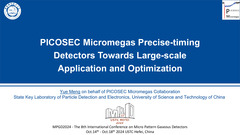PICOSEC Micromegas precise-timing detectors towards large-scale applications and optimization
ID:48
Submission ID:49 View Protection:ATTENDEE
Updated Time:2024-08-28 14:56:24
Hits:602
Oral Presentation
Abstract
Precise-timing detection techniques are in high demands for future particle physics experiments. PICOSEC Micromegas (MM) is a precise timing gaseous detector based on a Cherenkov radiator coupled with a semi-transparent photocathode and a MM amplifying structure. Single-channel prototype has successfully achieved a sub-25ps time resolution with MIP, followed by ongoing developments to make the concept suitable for physics applications. The main objective is to develop robust, large-area and scalable detectors with high time resolution, along with a dedicated fast-response readout electronics. New single-channel detector prototype was designed focusing on improving stability, reducing noise, ensuring signal integrity and achieving uniform time response over entire active area. Recent developments towards robust PICOSEC MM include producing resistive MM and optimizing robust photocathodes. Resistive MM equipped on the single-channel prototype obtained comparable precision to a non-resistive prototype, exhibiting an excellent time resolution of 12 ps. Alternative photocathodes, including Diamond Like Carbon (DLC) and Boron Carbide (\(B_{4}C\)) are measured in details as replacements for CsI, which can be easily damaged by ion back flow and discharges. Further progress includes the design and fabrication of a resistive 10ⅹ10 \(cm^2\) area multi-channel prototype, achieving a timing performance of 20 ps for individual pads. A large-area solution of 20ⅹ20 \(cm^2\) utilizing crystal splicing has been developed, facilitating further expansion to large area coverage. Meanwhile, two types of readout electronics systems—one with RF pulse amplifiers and SAMPIC-based waveform digitizers, another with RF amplifiers and DRS4-based waveform digitizers—have been developed and tested with the detectors, both achieving timing performance comparable to results obtained with oscilloscopes. Additionally, efforts have been made to find environmentally friendly gases as replacement of the original working gas, successfully reaching a time resolution of ~17 ps with a Ne/Iso mixture as an alternative to the standard \(Ne\)/\(CF_{4}\)/\(C_{2}H_{6}\) gas mixture. These advancements demonstrate the potential of PICOSEC MM to meet the stringent requirements of future particle physics experiments.
Keywords
Micromegas,time resolution,Photocathodes
Submission Author
Yue Meng
University of Science and Technology of China
Yi Zhou
ustc




Comment submit